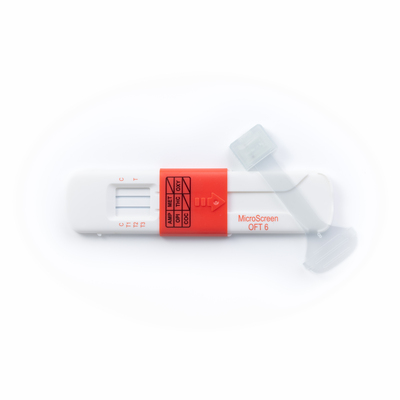Setting New Standards in Workplace Drug Testing

How updated testing standards and new technologies are shaping the future of workplace screening
Workplace safety remains one of the highest priorities for Australian and New Zealand industries — from transport and mining to healthcare and manufacturing. Drug and alcohol testing programs have long played a critical role in maintaining safe and compliant operations, but the technology and standards underpinning them are now entering a new phase.
As testing expectations evolve, workplaces are navigating the transition toward more accurate, accessible, and scientifically robust solutions that align with updated AS/NZS 4308:2023 (urine) and AS/NZS 4760:2019 (oral fluid) standards.
The latest changes represent an opportunity for organisations to strengthen both their compliance and confidence in testing outcomes, while making the process more efficient and user-friendly.
A new era of standards
The 2023 update to AS/NZS 4308 — governing urine drug testing — introduces several important refinements designed to improve accuracy, transparency, and fairness in workplace testing. These include:
- Lower screening and confirmation thresholds for key analytes such as cocaine, improving sensitivity and early detection.
- Stronger quality assurance, device verification, and chain-of-custody protocols to align with oral fluid testing practices.
- An optional oxycodone test panel inclusion, allowing employers to tailor programs to risk profiles.
While laboratories have until December 2026 to transition from the 2008 version, the shift marks a clear direction toward harmonised, evidence-based testing.
Meanwhile, the AS/NZS 4760:2019 oral fluid standard continues to gain traction, offering an alternative testing method that is less invasive, more tamper-resistant, and reflective of recent drug use.
The oral fluid standard refines detection thresholds for substances such as THC (cannabis) and oxycodone, and tightens chain-of-custody and consent requirements — further professionalising workplace screening practices.
Meeting the challenge: transitioning from urine to oral fluid
Across industries, many organisations are assessing how to balance traditional urine testing with the increasing demand for oral fluid screening. Oral fluid testing provides a practical and efficient solution for identifying recent drug use, particularly where immediacy and observed collection are key.
However, with growing adoption comes the need for greater laboratory throughput and robust confirmation testing, typically performed via mass spectrometry. As sample volumes increase, laboratories will need to adapt workflows and automation to maintain turnaround times and result reliability.
“Toxicology Laboratories have historically implemented an efficient process for urine screening using high throughput analysers to filter out negatives and focus on only those samples requiring confirmatory analysis. This same process is not generally practical for Oral Fluid samples at this stage, so Point-of-Care devices will remain the primary screening tool for the foreseeable future.”
— Bart Riley, Technical Applications Specialist, Thermo Fisher Scientific
Supporting compliance through innovation
Thermo Fisher Scientific has been supporting workplace safety programs for decades through its MicroScreen range of point-of-care testing devices and quality controls — including the Thermo Fisher Scientific MicroScreen 2, MicroScreen 2 Plus, MicroScreen SPLIT Cup, and the MicroScreen OFT oral fluid device.

Each product is designed to meet evolving compliance expectations under both urine and oral fluid testing standards, offering reliable on-site results that help reduce laboratory workload and enable faster decision-making.
The MicroScreen portfolio simplifies the screening process through:
- Built-in adulteration checks to ensure sample integrity.
- Tamper-evident designs supporting chain-of-custody compliance.
- Rapid, clear visual results aligned with AS/NZS 4308:2023 and AS/NZS 4760:2019 standards.
-
Flexible test configurations for commonly detected substances in workplace settings.
In high-risk environments such as mining, construction and transport where operational safety and productivity are tightly linked, point-of-care testing devices like MicroScreen help supervisors identify risks in real time, without waiting for off-site lab confirmation.
These devices are also being increasingly used across a number of industries where organisations are looking for reliable and compliant screening that fits into day-to-day workflows.

The road ahead
As technology evolves, oral fluid testing will continue to shape the future of workplace screening. The ability to test quickly, accurately, and non-invasively will support safer workplaces while meeting the expectations of both regulators and employees.
The challenge ahead lies in scaling laboratory confirmation testing to match this growth — ensuring that mass spectrometry and automation technologies can keep pace with demand, while maintaining the high analytical standards required for defensible results.
By combining updated national standards, robust laboratory practices, and innovative point-of-care devices, organisations can establish programs that are both scientifically sound and operationally efficient.
For Thermo Fisher Scientific, the goal remains clear:
to provide the science, tools, and support that make workplaces healthier, safer, and compliant — today and into the future.
Six conditions that can be treated with medical marijuana
Medical marijuana has shown promise as a viable treatment option for many health conditions;...
Why all saliva detection devices are not equal
There are a range of alternative products to choose from, so how can you identify that one that...








